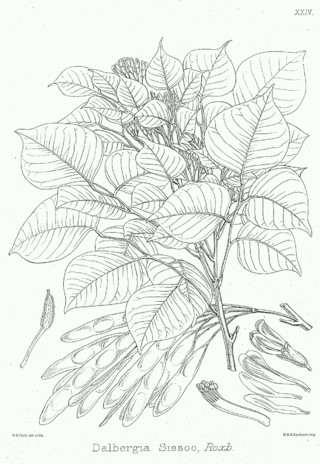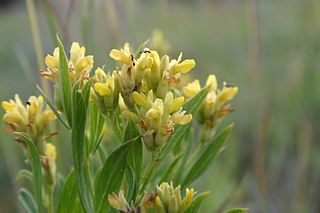
Abrus is a genus of flowering plants in the pea family, Fabaceae, and the only genus in the tribe Abreae. It contains 13–18 species, but is best known for a single species: jequirity. The highly toxic seeds of that species are used to make jewellery.

Dalbergia is a large genus of small to medium-size trees, shrubs and lianas in the pea family, Fabaceae, subfamily Faboideae. It was recently assigned to the informal monophyletic Dalbergia clade : the Dalbergieae. The genus has a wide distribution, native to the tropical regions of Central and South America, Africa, Madagascar and southern Asia.

Vigna is a genus of plants in the legume family, Fabaceae, with a pantropical distribution. It includes some well-known cultivated species, including many types of beans. Some are former members of the genus Phaseolus. According to Hortus Third, Vigna differs from Phaseolus in biochemistry and pollen structure, and in details of the style and stipules.

Cassia is a genus of flowering plants in the legume family, Fabaceae, and the subfamily Caesalpinioideae. Species are known commonly as cassias. The genus includes 37 species and has a pantropical distribution. Species of the genera Senna and Chamaecrista were previously included in Cassia. Cassia now generally includes the largest species of the legume subtribe Cassiinae, usually mid-sized to tall trees.

Zornia is a cosmopolitan genus of herbs from the legume family Fabaceae. It was recently assigned to the informal monophyletic Adesmia clade of the Dalbergieae.

Indigofera is a large genus of over 750 species of flowering plants belonging to the pea family Fabaceae. They are widely distributed throughout the tropical and subtropical regions of the world.

The plant tribe Phaseoleae is one of the subdivisions of the legume subfamily Faboideae, in the unranked NPAAA clade. This group includes many of the beans cultivated for human and animal food, most importantly from the genera Glycine, Phaseolus, and Vigna.

Baphia is a small genus of legumes that bear simple leaves. Baphia is from the Greek word βάπτω, referring to a red dye that is extracted from the heartwood of tropical species. The genus is restricted to the African tropics. Baphia was traditionally assigned to the tribe Sophoreae; however, recent molecular phylogenetic analyses reassigned Baphia to the tribe Baphieae.
Ormocarpum is a genus of flowering plants in the legume family, Fabaceae. It includes 17 species native to tropical and southern Africa and parts of India, Indochina, Malesia, Papuasia, and the South Pacific. The genus was recently assigned to the informal monophyletic Dalbergia clade of the Dalbergieae.
Phylloxylon is a genus of flowering plants in the Indigofereae tribe of the family Fabaceae. There are seven species, all endemic to Madagascar.

Tephrosia is a genus of flowering plants in the family Fabaceae. It is widespread in both the Eastern and Western Hemisphere, where it is found in tropical and warm-temperate regions.

Aeschynomene is a genus of flowering plants in the family Fabaceae, and was recently assigned to the informal monophyletic Dalbergia clade of the Dalbergieae. They are known commonly as jointvetches. They range across tropical and subtropical regions of the Americas, sub-Saharan Africa, south, southeast, and east Asia, and Australia. These legumes are most common in warm regions and many species are aquatic.

Pearsonia is a genus of 12 species of plants belonging to the family Fabaceae and occurring in Africa south of the equator with 1 species found on Madagascar. The species are usually herbs or shrublets with woody rootstocks. Leaves are usually sessile and 3-foliolate. The inflorescence is a congested or lax terminal raceme. The name of this genus commemorates the South African botanist Henry Harold Welch Pearson.

Argyrolobium is a genus of flowering plants in the family Fabaceae. It belongs to the subfamily Faboideae. Members of this genus are found in Africa, western and south Asia, and southern Europe.
Disynstemon paullinioides is a species of flowering plants in the family Fabaceae. It belongs to the subfamily Faboideae. It is a liana that is native to Madagascar. It is the only member of the genus Disynstemon.
Rhynchotropis is a genus of flowering plants in the legume family, Fabaceae. It includes two species of herbs native to the Democratic Republic of the Congo, Angola, and Zambia. Typical habitats include seasonally-dry tropical woodland and wooded grassland in the northern Zambezian region, often in seasonally-damp or open sandy and rocky areas. It belongs to tribe Indigofereae of subfamily Faboideae.

The tribe Indigofereae is a subdivision of the plant family Fabaceae. It is consistently recovered as a monophyletic clade in molecular phylogenies. The Indigofereae arose 30.0 ± 3.3 million years ago.

Indigastrum is a genus of flowering plants in the tribe Indigofereae of the family Fabaceae. It includes eight species native to sub-Saharan Africa, Yemen, India, and Australia.













